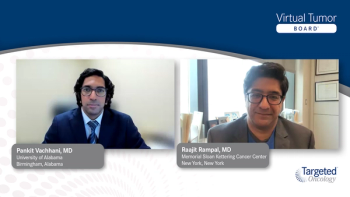
pMMR Recurrent EC: Optimal Selection and Sequencing of Therapy
Before closing out their discussion on the first patient case, key opinion leaders on endometrial carcinoma reflect on the optimal selection and sequencing of therapy in pMMR recurrent disease.
Episodes in this series

Transcript:
Robert L. Coleman, MD, FACOG, FACS: So getting back to this case, would you agree with this strategy of [paclitaxel/carboplatin] followed by lenvatinib/pembrolizumab, or would you try something different? We’ll have an opportunity to discuss other nuances, but I’m curious what your thoughts are on that. Michael, I’ll start with you.
Michael J. Birrer, MD, PhD: I actually completely concur with it. I think it’s reasonable. I would just add to that discussion about toxicities. The average dose in [keynote] 146 was 14 [mg]. I’m a purist just like you and start with 20 [mg].So I’m on board. I think this is reasonable.
Robert L. Coleman, MD, FACOG, FACS: Excellent. Krish, same?
Krishnansu S. Tewari, MD: Yes. Same thing for these mismatch repair proficient [pMMR] patients, I think it’s the practice-changing go-to second-line regimen at this point, maybe first-line soon.
Robert L. Coleman, MD, FACOG, FACS: We’ll talk about that at the end here. Because this is kind of like what we did with the PARP inhibitors and ovarian cancer. We kind of started that [with] recurrent multi-prior lines of therapy and moved it into a maintenance phase in the recurrent setting, then we moved it into a maintenance phase in the frontline setting. So that’s going to be kind of our trajectory here since it’s so active. Kimberly, anything else in your consideration or that you’ve seen in the practice? I had a discussion about this [recently] with another doctor, that this patient had a pretty significant response to treatment. So she had measurable disease, got paclitaxel/carboplatin, and had a complete remission. That’s not a very common thing. And then she’s NED [no evidence of disease] for 14 months. Now she’s come back with new disease that’s distant. Would you fault somebody thinking about retreating with [paclitaxel/carboplatin]?
Kimberly Halla, MSN, FNP-C: Of course not. I would not fault anybody for it.… So why get off a winning horse, right? If it worked the first time, who’s to say it’s not going to work a second time that way? So it’d be really hard [not] to say, “Let’s try something that may work great for you, but we know, carboplatin, paclitaxel worked well for you. Let’s try it again.” So I would not fault anybody for that. Absolutely not.
Robert L. Coleman, MD, FACOG, FACS: I agree. So, Mike, in the GOG [Gynecologic Oncology Group], we did a lot of work with anti-angiogenic agents. You mentioned lenvatinib as a single agent. We also looked at bevacizumab and VEGF-Trap [aflibercept]. And some people say, “Hey, listen, what about using an anti-angiogenics other than lenvatinib as a single agent in these patients?” What’s your thought about that?
Michael J. Birrer, MD, PhD: First of all, I think there’s no doubt that [bevacizumab], VEGF-Trap, [which] there’s less data for, and anti-angiogenic agents are active. There’s no issue about that. The thing that’s a little bit curious, even at this advanced stage where we’ve done these randomized trials, [and] lenvatinib is around, we still won’t really understand the synergism between the two. Because people have argued—I’ve been on advisory boards, [where they have] said, why don’t we bring in [bevacizumab in] combination with pembrolizumab? I don’t know if it would work…so that’s a little bit of a concern. But [bevacizumab] is active. I’ve actually treated some of these patients with [bevacizumab]/Cytoxan [cyclophosphamide], which is the ovarian regimen. It’s a little synergism, so it’s perfectly reasonable.
Robert L. Coleman, MD, FACOG, FACS: I’m with you on that as well. Krish, for a patient who progresses on [lenvatinib], what’s your go‑to strategy?
Krishnansu S. Tewari, MD: I think the problem is we just don’t have any data. We’re completely cast adrift at that point. So if it would been a while since they saw platinum [therapy], I would definitely retreat them, [with] PLD [pegylated liposomal doxorubicin] or doxorubicin. I don’t use doxorubicin on its own, but I could see using pegylated liposomal doxorubicin. It really becomes a problem when we get that far out.
Robert L. Coleman, MD, FACOG, FACS: Or weekly paclitaxel. The two control arms of this trial actually would’ve been reasonable. That sounds great. That was a great discussion, you guys. Thanks so much. I think we interrogated a lot of different pathways. This next case that we’re going to get into is going to be a dMMR [deficient mismatch repair] patient. So I’ll have a little more talk about on the immune angle for this. But we’ll get to that in just a second.
Transcript edited for clarity.












































